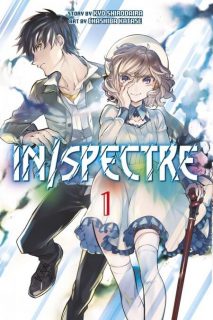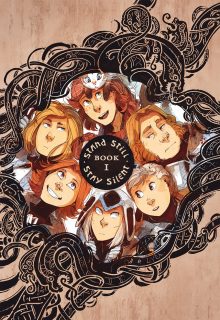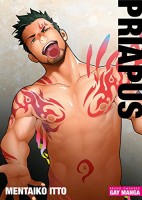My News and Reviews
After a slight delay, November’s Bookshelf Overload was posted last week at Experiments in Manga. Last week I also came to the sad conclusion that my feature on Ichigo Takano’s Orange simply isn’t going to happen despite the progress that I’ve made on it and all of my best efforts. I’d like to extend an apology to everyone who was looking forward to that post, myself included. Orange deeply resonated with me and my own experiences and I wanted to share that with others. Specifically, I wanted to write an essay exploring its sensitive, honest, and compassionate portrayal of the very personal challenges surrounding issues of guilt, depression, and suicide. Ironically, it’s partly due to my own mess of anxieties, et al. that I’m having so much trouble lately. Even when I have the inspiration and desire, I’m still having a terribly difficult time actually writing. So, I’m not sure when my long-form features will return–even though I miss writing and sharing them, I’m trying to be kind to myself by giving myself a bit of a break–but I hope that it is sooner rather than later. However, I can at least still commit to regularly posting My Week in Manga, Giveaways, and Bookshelf Overload features! It’s not much compared to my past output, but at least it is something. Oh, and I’ll definitely be posting my list of notable 2016 releases at the end of the month!
Quick Takes
 The Boy Who Cried Wolf by Mentaiko Itto. Bruno Gmünder’s Gay Manga line began in 2013 and the publisher has been slowly but steadily releasing gay erotic manga in English translation ever since. The Boy Who Cried Wolf is the second collection of Mentaiko Itto’s erotic doujinshi to be published by Bruno Gmünder. The volume collects three of Itto’s short manga: “Hamu and the Boy Who Cried Wolf,” “Holy Night,” and “As Swift as Lightning.” As I’ve come to expect from Itto’s work, in addition to uninhibited sex scenes there is also a fair amount of humor to be found in The Boy Who Cried Wolf as well as a great deal of heart. Unlike Priapus, Itto’s previous collection in translation, The Boy Who Cried Wolf is generally more realistic and less fantastic in nature. Granted, as a historical comedy of sorts, “As Swift as the Lightning” deliberately includes its fair share of anachronisms. But Itto actually incorporates some autobiographical elements in “Hamu and the Boy Who Cried Wolf,” a manga about a young man who is initially so deeply closeted that he unintentionally hurts the person he cares most about. However, because this is Itto, the story isn’t nearly as gloomy as that description sounds. The Boy Who Cried Wolf is a great collection of highly entertaining erotic manga. I truly hope that more of Itto’s work will be translated in the future.
The Boy Who Cried Wolf by Mentaiko Itto. Bruno Gmünder’s Gay Manga line began in 2013 and the publisher has been slowly but steadily releasing gay erotic manga in English translation ever since. The Boy Who Cried Wolf is the second collection of Mentaiko Itto’s erotic doujinshi to be published by Bruno Gmünder. The volume collects three of Itto’s short manga: “Hamu and the Boy Who Cried Wolf,” “Holy Night,” and “As Swift as Lightning.” As I’ve come to expect from Itto’s work, in addition to uninhibited sex scenes there is also a fair amount of humor to be found in The Boy Who Cried Wolf as well as a great deal of heart. Unlike Priapus, Itto’s previous collection in translation, The Boy Who Cried Wolf is generally more realistic and less fantastic in nature. Granted, as a historical comedy of sorts, “As Swift as the Lightning” deliberately includes its fair share of anachronisms. But Itto actually incorporates some autobiographical elements in “Hamu and the Boy Who Cried Wolf,” a manga about a young man who is initially so deeply closeted that he unintentionally hurts the person he cares most about. However, because this is Itto, the story isn’t nearly as gloomy as that description sounds. The Boy Who Cried Wolf is a great collection of highly entertaining erotic manga. I truly hope that more of Itto’s work will be translated in the future.
 In/Spectre, Volume 1 by Chasiba Katase. Although In/Spectre is based on the novel Invented Inference: Steel Lady Nanase by Kyo Shirodaira, Katase seems to have been given plenty of freedom in adapting the story as a manga series. If the note from the original author is to be believed, the currently ongoing In/Spectre manga is actually the more popular of the two renditions. Unsurprisingly, I was primarily drawn to the manga because yokai play a prominent role in the series. Considering the title I thought it might also be a mystery manga which, as it turns out, in some ways it is and in some ways it isn’t. I didn’t find the first volume of In/Spectre to be as engaging as I hoped it would be–at times the pacing can be agonizingly slow–but I am still greatly intrigued by the series. Now that the setting has been established and the rather peculiar characters have been introduced, I’m hoping that future volumes have more energy to them because I really do like the basic premise of the series. In/Spectre largely follows a young woman named Kotoko Iwanaga who has become a god of wisdom to Japan’s yokai. This has its benefits, but it also cost her an eye and a leg. She is responsible for helping to mediate disputes between yokai, but also for keeping the more unruly ones in check when humans are in danger.
In/Spectre, Volume 1 by Chasiba Katase. Although In/Spectre is based on the novel Invented Inference: Steel Lady Nanase by Kyo Shirodaira, Katase seems to have been given plenty of freedom in adapting the story as a manga series. If the note from the original author is to be believed, the currently ongoing In/Spectre manga is actually the more popular of the two renditions. Unsurprisingly, I was primarily drawn to the manga because yokai play a prominent role in the series. Considering the title I thought it might also be a mystery manga which, as it turns out, in some ways it is and in some ways it isn’t. I didn’t find the first volume of In/Spectre to be as engaging as I hoped it would be–at times the pacing can be agonizingly slow–but I am still greatly intrigued by the series. Now that the setting has been established and the rather peculiar characters have been introduced, I’m hoping that future volumes have more energy to them because I really do like the basic premise of the series. In/Spectre largely follows a young woman named Kotoko Iwanaga who has become a god of wisdom to Japan’s yokai. This has its benefits, but it also cost her an eye and a leg. She is responsible for helping to mediate disputes between yokai, but also for keeping the more unruly ones in check when humans are in danger.
 Persona 4, Volumes 2-5 by Shuji Sogabe. Though I suspect that I would enjoy it, I still haven’t actually played the original Persona 4 video game, so it’s difficult for me to directly compare Sogabe’s manga adaptation. However, I can say that for the most part the manga can stand alone as its own work. However occasionally it does feel as though the characters are being railroaded and the story has only one possible path to take, probably a remnant from the manga’s RPG origins. While overall the artwork is attractive and stylish, the action-oriented scenes and fight sequences can be somewhat lacking in their execution. But I love the themes that Persona 4 deals with, especially those of personal identity and self-acceptance. As the series progresses, concepts of gender and sexuality come into greater play as well which (as always) I find particularly interesting. In general like all of the characters, too. Yosuke can unfortunately be a homophobic ass from time to time, but I absolutely adore Kanji, a tough guy with a good heart who has traditionally feminine interests and hobbies. Much of the character and story development in Persona 4 is ambiguous enough that multiple and sometimes opposing readings and interpretations are possible, some of which are frankly unflattering. Personally, I prefer and am more comfortable with the more positive interpretations.
Persona 4, Volumes 2-5 by Shuji Sogabe. Though I suspect that I would enjoy it, I still haven’t actually played the original Persona 4 video game, so it’s difficult for me to directly compare Sogabe’s manga adaptation. However, I can say that for the most part the manga can stand alone as its own work. However occasionally it does feel as though the characters are being railroaded and the story has only one possible path to take, probably a remnant from the manga’s RPG origins. While overall the artwork is attractive and stylish, the action-oriented scenes and fight sequences can be somewhat lacking in their execution. But I love the themes that Persona 4 deals with, especially those of personal identity and self-acceptance. As the series progresses, concepts of gender and sexuality come into greater play as well which (as always) I find particularly interesting. In general like all of the characters, too. Yosuke can unfortunately be a homophobic ass from time to time, but I absolutely adore Kanji, a tough guy with a good heart who has traditionally feminine interests and hobbies. Much of the character and story development in Persona 4 is ambiguous enough that multiple and sometimes opposing readings and interpretations are possible, some of which are frankly unflattering. Personally, I prefer and am more comfortable with the more positive interpretations.
 Stand Still, Stay Silent, Book 1 by Minna Sundberg. The first book of Sundberg’s ongoing Stand Still, Stay Silent collects the award-winning webcomic’s prologue, first five chapters, and additional bonus content. It’s available in both digital and physical editions, but the hardcover print volume is absolutely gorgeous. Much like Sundberg’s earlier epic A Redtail’s Dream, Nordic influences are a major part of Stand Still, Stay Silent. The comic is stunningly illustrated with beautiful, full-color artwork. Stand Still, Stay Silent is a post-apocalyptic tale of adventure and exploration with an ominous touch of horror and the unknown. At the same time, the comic manages to be lighthearted and humorous. The prologue establishes the comic’s fascinating setting–a seemingly harmless disease which turns out to be fatal quickly spreads across the globe. Ninety years later, Iceland, which was able to completely close itself off from the rest of the world, has become the center of known civilization, but a team has been assembled to see what can be found beyond the relative safety of the Nordic countries. Despite scenes of intense terror and action, the plot of Stand Still, Stay Silent is actually on the slower side; the focus is almost entirely on the characters and their interpersonal dynamics. The character writing, worldbuilding, and humor in Stand Still, Stay Silent is simply fantastic.
Stand Still, Stay Silent, Book 1 by Minna Sundberg. The first book of Sundberg’s ongoing Stand Still, Stay Silent collects the award-winning webcomic’s prologue, first five chapters, and additional bonus content. It’s available in both digital and physical editions, but the hardcover print volume is absolutely gorgeous. Much like Sundberg’s earlier epic A Redtail’s Dream, Nordic influences are a major part of Stand Still, Stay Silent. The comic is stunningly illustrated with beautiful, full-color artwork. Stand Still, Stay Silent is a post-apocalyptic tale of adventure and exploration with an ominous touch of horror and the unknown. At the same time, the comic manages to be lighthearted and humorous. The prologue establishes the comic’s fascinating setting–a seemingly harmless disease which turns out to be fatal quickly spreads across the globe. Ninety years later, Iceland, which was able to completely close itself off from the rest of the world, has become the center of known civilization, but a team has been assembled to see what can be found beyond the relative safety of the Nordic countries. Despite scenes of intense terror and action, the plot of Stand Still, Stay Silent is actually on the slower side; the focus is almost entirely on the characters and their interpersonal dynamics. The character writing, worldbuilding, and humor in Stand Still, Stay Silent is simply fantastic.


